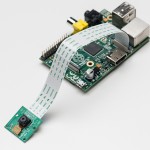1. Get the software ready
Ok so I am going to assume that you have a working PI on some kind of LAN with internet access, the next step as always is to update your PI ensuring you have the latest software and drivers installed.
|
1
2
|
sudo apt-get updatesudo apt-get upgrade |
Now we need to install the software, we are going to be using a great little application called Motion, this will do a few things for us including accessing the USB cam, getting the images, and streaming them via a built in web server. As the name suggests it will also track and trigger events on motion been detected in the video frames (more on that later).
|
1
|
sudo apt-get install motion |
2. Plug in your web cam
So now the software is on there it’s time to plug in the web cam and ensure that everything is working, ensuring that you plug it into the powered hub, and then into the PI. Otherwise the webcam will not get enough power to turn on.
When plugged in type the “lsusb” command, you should see a line there with your web cam manufacture, that proves that you have the basic connectivity working.
|
1
2
3
4
|
lsusb....Bus 001 Device 002: ID 04ea:1142 Microsoft Corp..... |
3. Configure the software
|
1
|
sudo nano /etc/motion/motion.conf |
In here there are a few basic changes that you need to perform:
- Daemon = OFF to ON
- webcam_localhost = ON to OFF
You can change other settings but it’s recommend you don’t take more than 2 frames, and you been the default frame pixel size, for stability.
4. Start the software
To ensure that the motion service will actually start as a daemon we need to change another configuration setting, so enter the following:
sudo nano /etc/default/motion
Then change the value “start_motion_daemon=no” to “yes”
Finally you can start the motion service to stream the web cam images
|
1
|
sudo service motion start |
Quick Example ImageThen after about 30 seconds browse to the new web interface, which should be at the below URL (where 192.168.0.100 is your Raspberry PI’s IP address)
http://192.168.0.100:8081
5. Final Tweeks
Web Port
You could change the web interface port to 80 (from the default 8081), so that you can just browse to the IP address without having to put :8081 at the end, it’s really simple to do, just:
|
1
|
sudo nano /etc/motion/motion.conf |
And then change “webcam_port 8081″ to “webcam_port 80″, save the file, and restart the motion service.
|
1
|
sudo service motion restart |
Port Forwarding
Final suggestion is enable port forwarding on your home broadband router to the Raspberry PI on port 80, that will mean you can access the web cam from anywhere in the world. There are too many routers in the word to explain how to do it here, but I am sure you will find some help on Google, if not please just leave a comment.
Warning; If you give it internet access via port forwarding this does take up quite a bit of bandwidth, and anyone can see your webcam feed, so only show what you want people to see.
[post_view]

